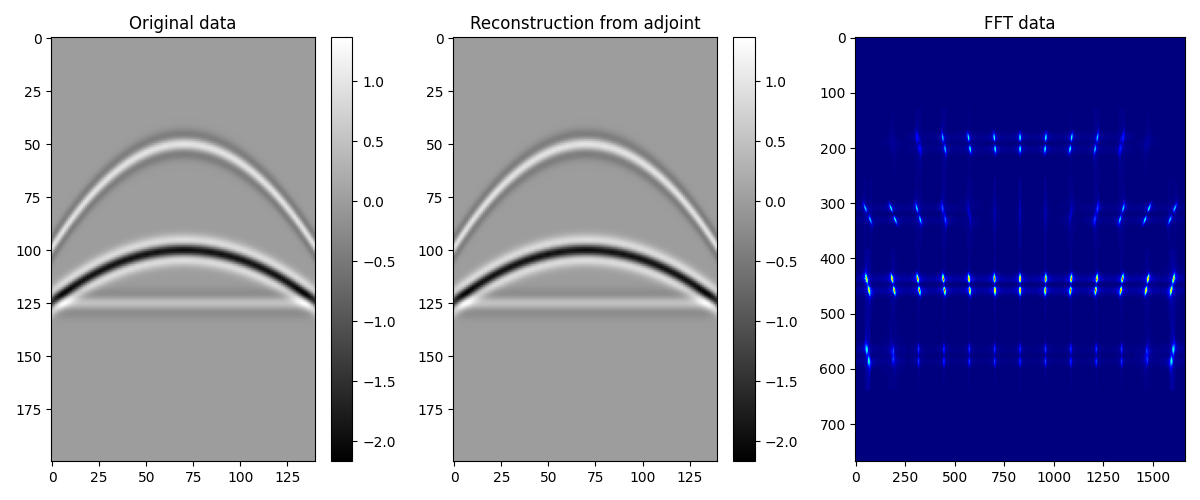Note
Click here to download the full example code
2D Patching¶
This example shows how to use the pylops.signalprocessing.Patch2D
operator to perform repeated transforms over small patches of a 2-dimensional
array. The transform that we apply in this example is the
pylops.signalprocessing.FFT2D but this operator has been
design to allow a variety of transforms as long as they operate with signals
that are 2-dimensional in nature, respectively.
import matplotlib.pyplot as plt
import numpy as np
import pylops
plt.close("all")
Let’s start by creating an 2-dimensional array of size \(n_x \times n_t\) composed of 3 parabolic events
par = {"ox": -140, "dx": 2, "nx": 140, "ot": 0, "dt": 0.004, "nt": 200, "f0": 20}
v = 1500
t0 = [0.2, 0.4, 0.5]
px = [0, 0, 0]
pxx = [1e-5, 5e-6, 1e-20]
amp = [1.0, -2, 0.5]
# Create axis
t, t2, x, y = pylops.utils.seismicevents.makeaxis(par)
# Create wavelet
wav = pylops.utils.wavelets.ricker(t[:41], f0=par["f0"])[0]
# Generate model
_, data = pylops.utils.seismicevents.parabolic2d(x, t, t0, px, pxx, amp, wav)
We want to divide this 2-dimensional data into small overlapping
patches in the spatial direction and apply the adjoint of the
pylops.signalprocessing.FFT2D operator to each patch. This is
done by simply using the adjoint of the
pylops.signalprocessing.Patch2D operator. Note that for non-
orthogonal operators, this must be replaced by an inverse.
nwins = (13, 6)
nwin = (20, 34)
nop = (128, 128)
nover = (10, 4)
dimsd = data.shape
dims = (nwins[0] * nop[0], nwins[1] * nop[1])
# Sliding window transform without taper
Op = pylops.signalprocessing.FFT2D(nwin, nffts=nop)
Slid = pylops.signalprocessing.Patch2D(
Op.H, dims, dimsd, nwin, nover, nop, tapertype=None, design=False
)
fftdata = Slid.H * data.ravel()
We now create a similar operator but we also add a taper to the overlapping parts of the patches. We then apply the forward to restore the original signal.
Slid = pylops.signalprocessing.Patch2D(
Op.H, dims, dimsd, nwin, nover, nop, tapertype="hanning", design=False
)
reconstructed_data = Slid * fftdata.ravel()
reconstructed_data = np.real(reconstructed_data.reshape(dimsd))
Finally we re-arrange the transformed patches so that we can also display them
fftdatareshaped = np.zeros((nop[0] * nwins[0], nop[1] * nwins[1]), dtype=fftdata.dtype)
iwin = 1
for ix in range(nwins[0]):
for it in range(nwins[1]):
fftdatareshaped[
ix * nop[0] : (ix + 1) * nop[0], it * nop[1] : (it + 1) * nop[1]
] = np.fft.fftshift(
fftdata[nop[0] * nop[1] * (iwin - 1) : nop[0] * nop[1] * iwin].reshape(nop)
)
iwin += 1
Let’s finally visualize all the intermediate results as well as our final
data reconstruction after inverting the
pylops.signalprocessing.Sliding2D operator.
fig, axs = plt.subplots(1, 3, figsize=(12, 5))
im = axs[0].imshow(data.T, cmap="gray")
axs[0].set_title("Original data")
plt.colorbar(im, ax=axs[0])
axs[0].axis("tight")
im = axs[1].imshow(reconstructed_data.T, cmap="gray")
axs[1].set_title("Reconstruction from adjoint")
plt.colorbar(im, ax=axs[1])
axs[1].axis("tight")
axs[2].imshow(np.abs(fftdatareshaped).T, cmap="jet")
axs[2].set_title("FFT data")
axs[2].axis("tight")
plt.tight_layout()

Total running time of the script: ( 0 minutes 0.670 seconds)